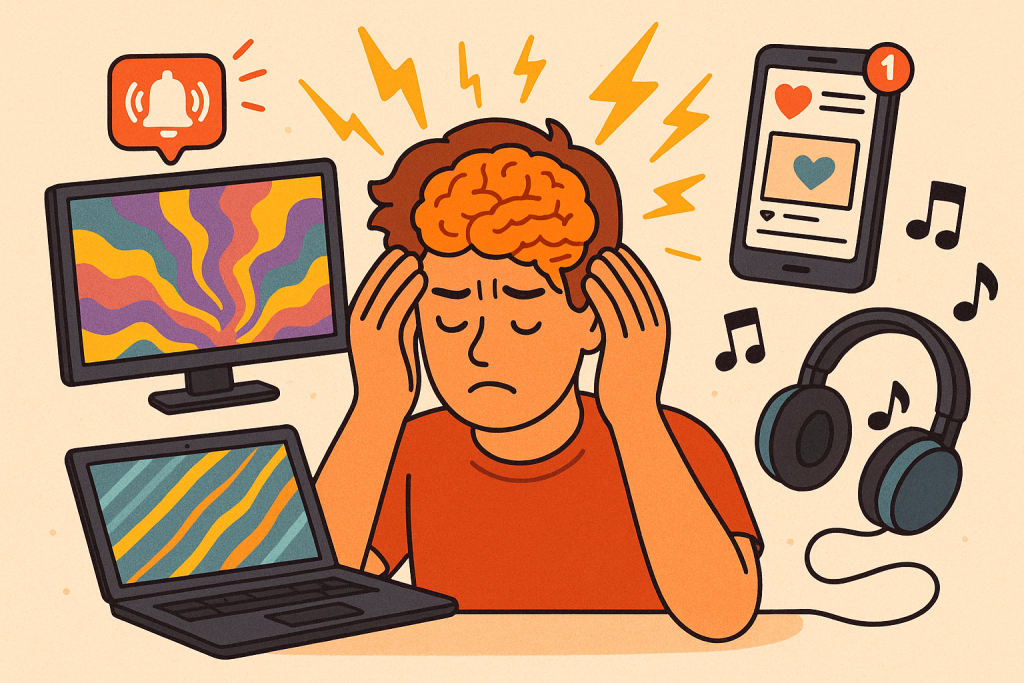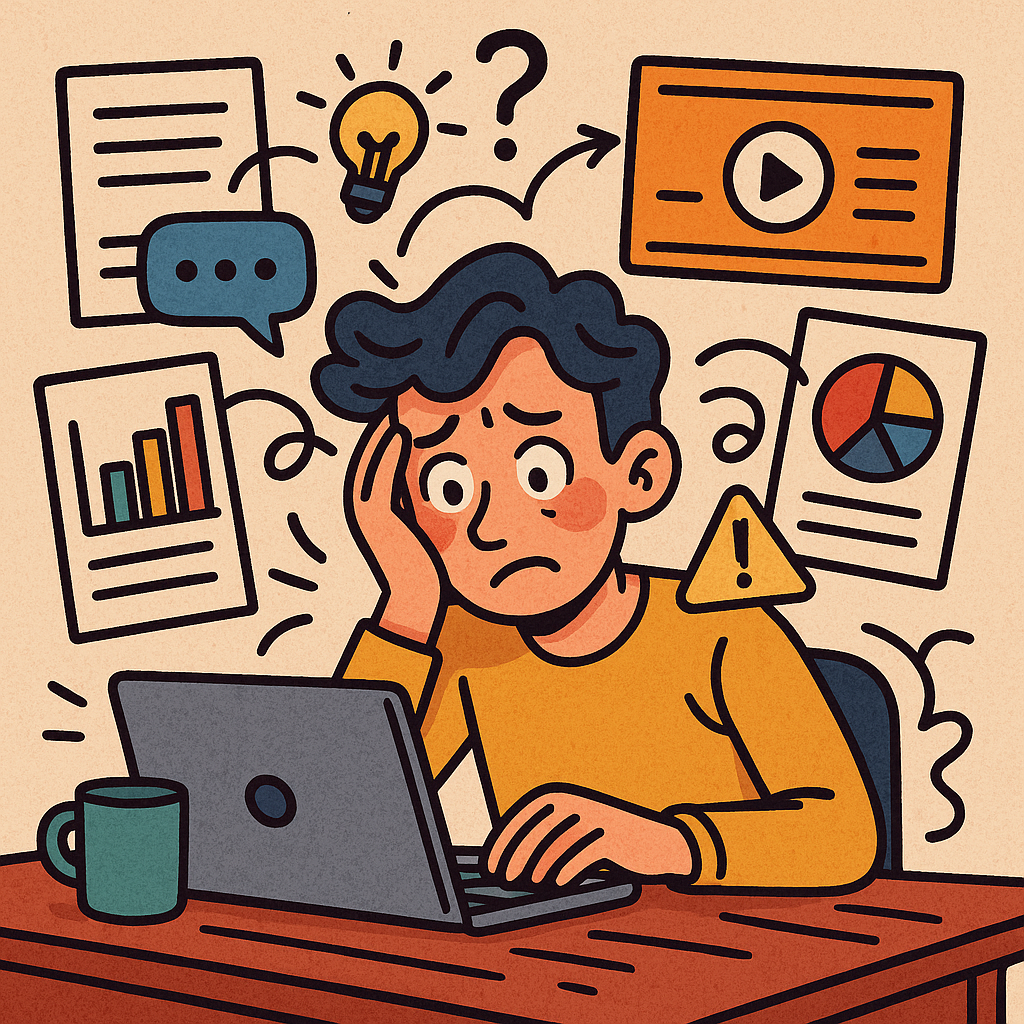It’s essential to protect your brain from overstimulating inputs, from endless notifications to rapid-fire social feeds. This guide offers science-backed strategies to help you regain focus, reduce stress, and strengthen mental resilience—all without sounding preachy or dull.

What Counts as Overstimulating Input?
Modern life bombards us with sensory input:
- Push notifications from apps, emails, and messages
- Social media scrolling that triggers dopamine responses
- Multitasking across screens: smartphone, laptop, TV
- Constant news updates and rapid-fire alerts
Recent neuroscience research shows that frequent interruptions fragment attention, making deep work difficult and increasing stress levels¹. Staying constantly “on” depletes mental bandwidth and can impair memory formation².
Why It Matters in 2025
Emerging trends show digital burnout on the rise. A 2024 survey by the American Psychological Association found that 61% of adults felt regularly overwhelmed by the volume of information they consume³. As remote work persists and screen time remains high, the problem isn’t going away. That makes it more important than ever to learn how to protect your brain from overstimulating inputs.
1. Conduct a Digital Audit
Start with awareness:
- Track average screen time across devices for a week.
- Log app use—especially social media, news, and messaging.
- Identify your biggest alerts and interruptions.
Once you know where distractions lie, you can tailor controls to specifically protect your brain from overstimulating inputs.
2. Set Alert Boundaries
Notification overload is a major culprit. Use these strategies:
- Mute non-essential alerts: only allow essential calls or messages.
- Schedule “notification windows”: check alerts at set intervals (e.g., top of hour).
- Enable Focus Mode or Do Not Disturb during focused work or rest.
Studies show that batching notifications (rather than responding instantly) reduces mental fatigue and improves concentration⁴.
3. Embrace Single-Tasking
Multitasking overloads working memory and reduces efficiency. To single-task effectively:
- Remove open browser tabs.
- Close apps you’re not using.
- Decide on one goal per session.
- Break tasks into 25-minute Pomodoro intervals, with 5-minute breaks.
This method aligns with research indicating better performance and less mental stress when tackling one task at a time.
4. Take Regular Digital Breaks
Constant digital intake is not sustainable. Try these breaks:
- The 20-20-20 rule: every 20 minutes, look 20 feet away for 20 seconds—reduces eye strain.
- Digital Sabbaths: a few tech-free hours daily for leisure, connection, or nature.
- Scheduled tool-free weekends or evenings: recharge your neurological resources.
Breaking screen dependency helps protect your brain from overstimulating inputs by giving your nervous system time to reset.
5. Redesign Your Environment
Your physical space affects your attention:
- Keep your phone in another room while working.
- Use minimalist desk setups—remove clutter and unnecessary screens.
- Add plants or natural light to reduce cognitive fatigue.
A calm environment boosts mental clarity and makes it easier to resist distractions.
6. Optimize Content Consumption
We can’t eliminate input—but we can choose high-quality, low-intensity content:
- Use read-it-later apps to consume long-form articles calmly.
- Subscribe to digest emails or newsletter summaries to reduce inbox chaos.
- Use audio over video; podcasts or music playback don’t demand your eyes.
- Limit social feeds to curated lists—no random scrolling.
By lowering intensity and curation is key to buffer against excessive stimulation.
7. Strengthen Your Mental “Filters”
Train your brain over time:
- Mindfulness meditation (10–15 minutes daily) improves attention control and reduces distractibility⁵.
- Breathing exercises interrupt racing thoughts.
- Journaling offloads mental clutter and reduces cognitive load.
Think of these practices as building muscle: regular small habits yield big neurological benefits.
8. Quality Sleep Is Non-Negotiable
Your brain’s ability to cope depends on restorative sleep:
- Blue light blocking after 8 pm reduces melatonin suppression.
- Keep devices out of the bedroom.
- Aim for 7–9 hours of quality, uninterrupted sleep.
Poor sleep worsens sensitivity to overstimulation—making all your efforts less effective.
Emerging Trend: Sensory-Friendly “Mind Hotels”
The wellness world is responding. New retreats—called mind hotels—offer:
- Silent digital zones
- Low-stimulation rooms with soft lighting and no tech
- Guided mindfulness and grounding sessions
These retreats provide a physical environment designed to help guests disconnect and reset. It’s a glimpse of the future: spaces that explicitly help us protect our brain from overstimulating inputs.
Structuring Your Daily Digital Diet
A sample day to stay sharp:
| Time | Action | Purpose |
|---|---|---|
| 7:00 am | Morning mindfulness + no phone | Start focused, calm |
| 8–10 am | Single-task work; phone in other room | Maximum productivity without interruptions |
| 10 am | 10-minute break (digital-free) | Rest eyes, mind |
| 12:00 pm | Phone catch-up session | Batching alerts effectively |
| 1–4 pm | Deep work blocks with Pomodoro method | Sustained creative or analytical output |
| 4:00 pm | Walk or break without screens | Recharge from cognitive fatigue |
| 6:00 pm | Dinner + social time without devices | Improve relationships, reduce phone reliance |
| 8:00 pm | Evening wind-down: reading, journaling | Prepare brain for quality sleep |
| 10:00 pm | Lights out; devices outside bedroom | Align circadian rhythm for optimal recovery |
Why These Strategies Work
- Neuroscience: Fewer interruptions leads to stronger focus networks in the prefrontal cortex.
- Psychology: Reducing novelty resets hedonic adaptation—making less stimulation feel satisfying.
- Behavioral science: Small habit changes (e.g., notification batching) yield compound benefits over time.
If you’re serious about improving mental clarity, resilience, and emotional balance, this approach offers both theory and practice.
Final Takeaways
- Identify your overstimulation triggers.
- Set strict boundaries on notifications.
- Practice single-tasking and scheduled breaks.
- Optimize your home/work space for focus.
- Build resilience through mindfulness and breathwork.
- Prioritize sleep and consider retreats for deeper resets.
By applying these habits consistently, you actively protect your brain from overstimulating inputs, allowing for deeper focus, improved memory, calmer moods—and a sense of control in a noisy world.
Ready to reclaim your attention? Start with one change today, like silencing most notifications or scheduling your first digital-free evening. Your brain will thank you.
References
McEwen, B.S. & Nakamura, N.H. (2005). Protecting the brain from overactivity: The role of neuropeptide Y in preventing glutamate-induced neuronal damage. Rockefeller University News. Retrieved from https://www.rockefeller.edu/news
Medical News Today. (2019). Sensory overload: Symptoms, causes, and treatment. Retrieved from https://www.medicalnewstoday.com/articles/sensory-overload
Neuroscience News. (2025). Boredom Is Good for You: Why Embracing It Calms the Brain. Retrieved from https://neurosciencenews.com






